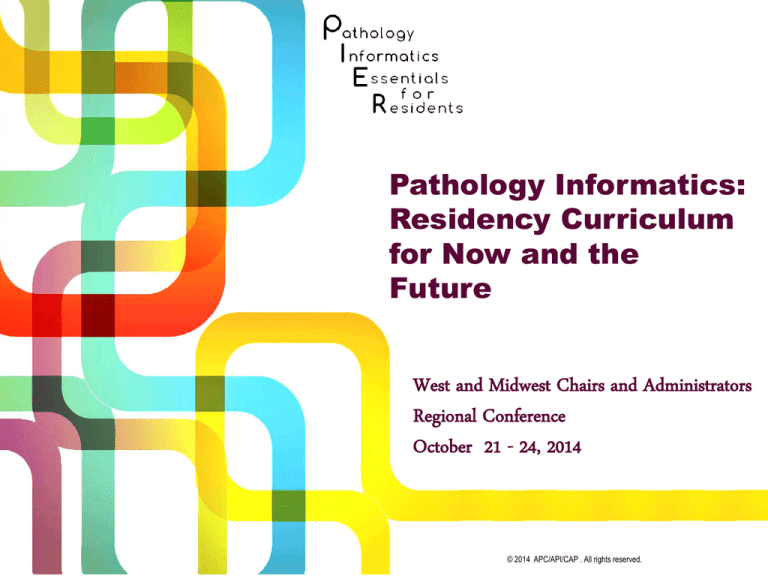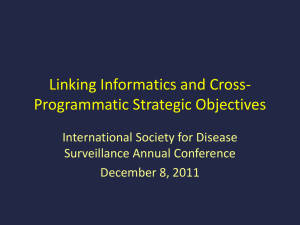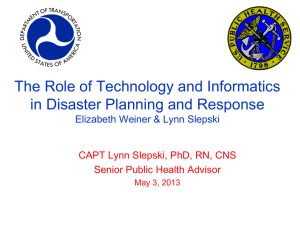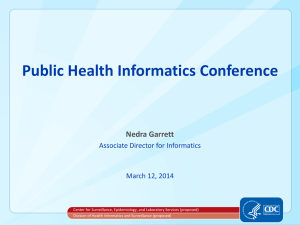
Pathology Informatics:
Residency Curriculum
for Now and the
Future
West and Midwest Chairs and Administrators
Regional Conference
October 21 - 24, 2014
© 2014 APC/API/CAP . All rights reserved.
Informatics Training in Pathology
“The landscape of medical
practice is changing…
Appropriate exposure to and
training in informatics will be
essential…Developing a
strong informatics
component for residency
training programs will help
advance the
transformational future of
the practice of medicine.”
Sinard JH, Powell SZ, Karcher DS. Pathology training in informatics: Evolving to meet a
growing need. Arch Pathol Lab Med 2014 (April);138:505-511.
© 2014 APC/API/CAP. All rights reserved.
2
What is PIER?
• Pathology Informatics
Essentials for Residents
• Collaborative joint project
of APC, API and CAP
• Instructional resource guide
and toolkit
• Support for PRODS
to address unmet needs for
pathology informatics training
• Mapped to ACGME
milestones in informatics
for pathology residents
© 2014 APC/API/CAP. All rights reserved.
3
PIER Developed by Pathology
Informatics Experts and PRODS
Core Team
Drs. Walter Henricks and Liron Pantanowitz (co-leaders)
Dr. Donald Karcher
Priscilla Markwood
Ann Neumann
Sue Plath
Working Group
Dr. Raymond D. Aller
Dr. Suzanne Zein-Eldin Powell
Dr. Philip J. Boyer
Dr. Michael Warren Riben
Dr. Victor Borisovich Brodsky
Dr. Rodney A. Schmidt
Dr. Alexis B. Carter
Dr. John H. Sinard
Dr. Rajesh C. Dash
Dr. Enrique Terrazas
Dr. Michael D. Feldman
Dr. J. Allan Tucker
Dr. John R. Gilbertson
Dr. J. Mark Tuthill
Dr. James H. Harrison, Jr
Dr. Myra L. Wilkerson
Dr. Anil V. Parwani
© 2014 APC/API/CAP. All rights reserved.
4
Benefits
Residents
Program Directors
• Receive uniform, high
quality training in a flexible
and timely manner
• Gain essential pathology
informatics knowledge and
skills
• Be well-prepared to apply
pathology informatics to
collect, manage and share
key medical information with
colleagues and patients
Receive:
• Up-to-date content suitable
for AP &/or CP
• Scalable design based on
program characteristics and
needs
• User-friendly toolkit for
flexible implementation
• Content updates/releases
• Relevant performance
outcomes mapped to
ACGME milestones
© 2014 APC/API/CAP. All rights reserved.
5
PIER Release Plan
• Release 0
– Introduced at July 2014 APC Annual Meeting
– Illustrated design, content and support
features
• Release 1
– Available now on APC PIER web page
– Will be alpha tested starting in November
– Available for use by all residency programs
during alpha testing
© 2014 APC/API/CAP. All rights reserved.
6
PIER Scope and
Sequence
7
The PIER Essentials Align to
ACGME Informatics Milestones
SBP7: Informatics: Explains, discusses, classifies, and applies clinical informatics (APCP)
Has not
Achieved
Level 1
Level 1
Level 2
Demonstrates
familiarity with
basic
technical
concepts of
hardware,
operating
systems, and
software for
general
purpose
applications.
Understands lab
specific software,
key technical
concepts and
subsystems on
interfaces,
workflow, barcode
applications,
automation
systems
(enterprise
systems
architecture).
Level 3
Applies
informatics skills
as needed in
project
management
(data
management,
computational
statistics).
Level 4
Level 5
Participates in
operational and
strategy meetings,
apprentices
troubleshooting with
IT staff, applies
informatics skills in
laboratory
management and
integrative
bioinformatics (able
to aggregate multiple
data sources and
often multiple data
analysis services).
Is proficient in medical
informatics systems.
Able to assess and
purchase a laboratory
information system for
anatomic and/or
clinical pathology
laboratories.
Able to utilize medical
informatics in the
direction and
operation of the
laboratory.
Comments:
© 2014 APC/API/CAP. All rights reserved.
8
PIER Scope and Sequence
PIER Essentials 1
PIER Essentials 2
• LIS Components & Functions
• Specialized LISs & Middleware
• Data & Communication Standards
• Digital Imaging
• Basics of the Health Care Information
Ecosystem
• Informatics in Pathology Practice
• Information Systems Fundamentals
• Importance of Databases
• Introduction to Data Standards
• Data Availability & Security
Entry-Level Proficiency
ACGME Milestone Level 1
Instructional Hours: 4-6
Basic Proficiency
ACGME Milestone Level 2
Instructional Hours: 8-10
PIER Essentials 3
• Pathologist Role in LIS & EHR Projects
• LIS Installation & Configuration
• Information Systems & Laboratory
Performance
• Data Security, Regulatory & Accreditation
Requirements
PIER Essentials 4
• LIS Management & Oversight
• Order and Results Management
• Laboratory Data for Quality
Improvement & Research
• Laboratory Data & Enterprise Health
Care Analytics
Advanced Proficiency
ACGME Milestone Level 4
Instructional Hours: 10-14
Intermediate Proficiency
ACGME Milestone Level 3
Instructional Hours: 10-12
© 2014 APC/API/CAP. All rights reserved.
9
PIER Essentials 1
PIER Essentials 1
•
•
•
•
•
Informatics in Pathology Practice
Information Systems Fundamentals
Importance of Databases
Introduction to Data Standards
Data Availability & Security
Entry Level Proficiency
ACGME Milestone Level 1
Instructional Hours: 4-6
© 2014 APC/API/CAP. All rights reserved.
10
PIER Essentials 2
PIER Essentials 2
•
•
•
•
•
LIS Components & Functions
Specialized LISs & Middleware
Data & Communication Standards
Digital Imaging
Basics of the Health Care
Information Ecosystem
Basic Proficiency
ACGME Milestone Level 2
Instructional Hours: 8-10
© 2014 APC/API/CAP. All rights reserved.
11
PIER Essentials 3
PIER Essentials 3
• Pathologist Role in LIS & EHR
Projects
• LIS Installation & Configuration
• Information Systems & Laboratory
Performance
• Data Security, Regulatory &
Accreditation Requirements
Intermediate Proficiency
ACGME Milestone Level 3
Instructional Hours: 10-12
© 2014 APC/API/CAP. All rights reserved.
12
PIER Essentials 4
PIER Essentials 4
• LIS Management & Oversight
• Order and Results Management
• Laboratory Data for Quality
Improvement & Research
• Laboratory Data & Enterprise Health
Care Analytics
Advanced Proficiency
ACGME Milestone Level 4
Instructional Hours: 10-14
© 2014 APC/API/CAP. All rights reserved.
13
Scope of Content
In Scope
• PIER topics cover what all pathologists need to
know for practice
• Content will be maintained to accommodate
changing technologies
Out of Scope
• Statistics
• Bioinformatics
• Programming
© 2014 APC/API/CAP. All rights reserved.
14
PIER Resource Toolkit
15
Overview
• PIER Scope and Sequence
– Identifies the “what” to teach
• PIER Resource Toolkit
– Identifies the “how” to teach
• Programs have unique needs and
approaches
– Toolkit helps PRODS scale topics
– Provides implementation options to meet
program needs
– Helps PRODS make good training decisions
© 2014 APC/API/CAP. All rights reserved.
16
Organization
• There are 3 key tools for each of the PIER
Essentials:
– Essentials Map
– Resource Options
– Outcomes Achievement Checklist
© 2014 APC/API/CAP. All rights reserved.
17
Essentials Map
• Top area
– Main topics
– Rationale
– Outcomes for
achievement
– Topic content
• Lower area
• Implementation
strategies
• Scheduling/progress
tracker
© 2014 APC/API/CAP. All rights reserved.
18
Essentials 1 Map: Top Area
Topic Title
Rationale
Outcomes for
Achievement
Informatics in Pathology
Practice
Information Systems
Fundamentals
Importance of Databases
The practice of pathology
relies on the creation,
management, and
accurate and timely
communication of clinical
laboratory information.
Understand the relevance
of informatics in pathology
practice.
Computers are essential
tools that pathologists use
in the management of
information for laboratory
practice and patient care.
Databases provide core
structure and tools that
enable pathologists to
manage and analyze large
amounts of information.
Use correct terminology to
describe the major types
and components of
computer hardware,
software, and computer
networks.
Conversant in the
fundamentals of
databases, including data
types, fields, records,
database structure, and
mechanisms for querying
data; understands how
data storage affects data
retrieval options.
1. Hardware
2. Software
Describe the difference
between information
technology (IT) and
informatics and recognize
how pathologists
contribute to informatics
initiatives.
Content
Explain the salient
differences and similarities
among pathology
informatics, bioinformatics,
public health informatics,
health care information
technology and health
knowledge informatics.
1. Definition of informatics
2. Relevance of
informatics in pathology
3. Different types of
informatics
4. The practice of
informatics in pathology
3. Networks
4. Communications
5. Internet / Web
Introduction to Data
Standards
Data Availability &
Security
Standards enable sharing
of data among different
health care information
systems (ie,
interoperability), which is
necessary for patient care.
Define the types and roles
of standards used in
pathology, at a basic level.
Pathologists are ultimately
responsible for the access
to and safety of pathology
information.
1. Database terminology
1. Messaging protocols
2. Structured vs.
Unstructured data
1. Data protection and
confidentiality
2. Data models
3. Interoperability
2. Data availability &
integrity
4. Introduction to coding
systems
3. Data backup & recovery
3. Types of databases
4. Use of databases
© 2014 APC/API/CAP. All rights reserved.
Understand the elements of
data availability as a key
part of security.
19
Resource Options
• Lists content sources to
support self-study or to
inform the development
of didactic materials
• Identifies recommended
PIER resources,
practical exercises and
other optional resources
• Provides a detailed
scheduling and progress
tracker
© 2014 APC/API/CAP. All rights reserved.
20
Outcomes Achievement Checklist
• Documents progress
and accomplishments
• Completion of
Essentials documents
completion of
corresponding ACGME
informatics milestone
level
• Final sign-off goes into
resident’s file
© 2014 APC/API/CAP. All rights reserved.
21
Alpha Testing and Deployment
• Testing Goals
– Obtain feedback on PIER materials
– Obtain feedback on implementation challenges
and success tips
• Deployment Goals
– Gather additional tools and resources that can
be shared across programs
– Build a cadre of programs that endorse PIER
to foster deployment to additional institutions
over time
© 2014 APC/API/CAP. All rights reserved.
22
Alpha Test Residency Programs
• Baystate Medical
Center
• Cleveland Clinic
• George Washington
University
• Medical University of
South Carolina
• University of Buffalo
• University of Kentucky
• University of New
Mexico
• University of Miami
• University of Pittsburgh
• University of Southern
California
• University of Toledo
• University of Washington
• University of Vermont
• Vanderbilt University
© 2014 APC/API/CAP. All rights reserved.
23
Alpha Test Residency Programs
• Baystate Medical
Center
• Cleveland Clinic
• George Washington
University
• Medical University of
South Carolina
• University of Buffalo
• University of Kentucky
• University of New
Mexico
• University of Miami
• University of Pittsburgh
• University of Southern
California
• University of Toledo
• University of Washington
• University of Vermont
• Vanderbilt University
© 2014 APC/API/CAP. All rights reserved.
24
Our Hope: Widespread PIER
Adoption and Implementation
• PIER seeks to ensure that all pathology
residents acquire the informatics knowledge and
skills needed for the modern practice of pathology
• We need your
leadership for
pathology residency
programs to achieve
this outcome together
© 2014 APC/API/CAP. All rights reserved.
25
Q&A
Bookmark PIER materials at:
http://www.apcprods.org/PIER/
26
Presentation Follow Up
• Direct any post meeting
questions to Sue Plath, CAP
Education Manager at
splath@cap.org
© 2014 APC/API/CAP. All rights reserved.
27
Thank You For
Your Interest
And Support
© 2014 APC/API/CAP . All rights reserved.









